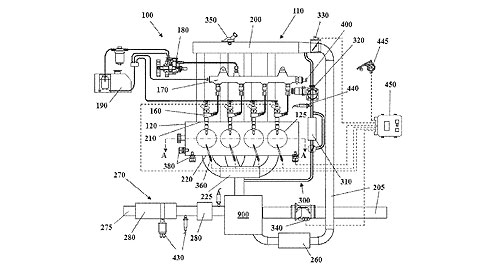Make / Model Search
News - General MotorsGM files staged turbo patentBypassing convention: GM's secret turbo bypassing valve claims to eliminate compromises in the traditional staged turbocharger system design, improving on systems such as BMW's dual turbo-diesel engine. Innovative serial sequential turbo idea revealed in General Motors patent requestGallery Click to see larger images 29 Jun 2016 GENERAL Motors has been rumbled trying to protect an idea that could be the next significant step forward in asymmetric staged twin turbocharging, with a leaked patent document that describes an innovative bypass system. North American publication GMInsideNews acquired the patent application, which was lodged in May in the United States, but is cross-referenced to a previous application made in the United Kingdom in 2014, which could indicate Vauxhalls involvement in its development. Connecting a pair of different sized turbos in series and directing exhaust gasses according to engine speed or load is not new to the automotive world, with many manufacturers using the principle to minimise boost a low engine speed without compromising maximum boost at higher speed, but GM's system is simpler. While other solutions are effective, the use of two turbos and the associated exhaust and induction plumbing is often as cumbersome as the engine itself and can generate losses, but GM's bypass valve seeks to reduce under-bonnet clutter with associated efficiency gains. Like other semi-compounded layouts, at low engine speeds the GM system directs exhaust gasses into the turbine of a smaller turbo (a variable geometry type in the case of the patented idea) before exiting and flowing through a second larger turbo. In this stage the smaller turbo is capable of accelerating up to the so-called boost threshold, at which useful manifold pressure is produced to increase power and torque output. Gasses entering the second turbo have a lesser effect but assist in starting rotation of the larger turbine. At higher engine speeds the flow of exhaust is directed past the smaller turbo and only into the larger second stage turbo where it can accelerate the larger compressor, producing full boost pressure and volume. Where GM's system differs is in the bypass valve design. Other systems can use several valves at different points in the system and require their own ducting, actuators and wiring, but the North American car giant's system incorporates all exhaust flow management into a single unit with one actuator, located in the exhaust manifold. According to the patent application the design “limits the mechanical complexity of the bypass system... simplifies the overall system” and could lead to “optimizing both the turbine's inlet ducts and without impairing the performance in either power or low end ranges”. The essence of the simpler system is that the pair of butterfly valves that control exhaust flow to either turbo are connected by a single spindle operated by one actuator. When the smaller turbine valve is open, the large turbo passage valve is rotated through 90-degrees, blocking the flow of gas, but when the actuator operates, the tract to the larger turbo opens while simultaneously rotating the smaller turbo valve to the closed position. This feature has the added advantage of providing a physical obstruction to the smaller turbine allowing the system to retain enthalpy joules – or the total amount of heat energy in the gasses – which boosts compressor efficiency and reduces lag. The system is incorporated into the engine management computer and is capable of operating under a number of different maps, allowing the valve to switch the path of gasses according to engine speed, load, temperature and environmental conditions. GM has not specified in its application whether the system is to be applied to either a petrol or diesel engine, although nothing in the design appears to limit its application to either spark or compression cycles. A four-cylinder engine is depicted in the accompanying diagrams, but it is not known what the car-maker will first apply the technology to, or if the technology will make it out of the patent office archives at all. With the advent of electric superchargers and electrically driven centrifugal compressors that can respond almost instantly providing lag-free boost, the patented idea may already have been superseded.  Read more |
Click to shareGeneral Motors articlesMotor industry news |














Facebook Twitter Instagram